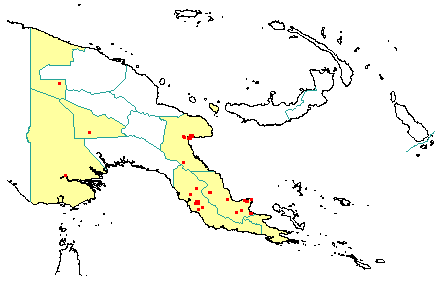
in PNGplants database
PNGTreesKey – Melicope bonwickii (F.Muell.) T.G.Hartley |
Barry Conn (NSW) & Kipiro Damas (LAE).
Guide to trees of Papua New Guinea
Copyright held by the authors, National Herbarium of New South Wales, and Papua New Guinea National Herbarium
Sandakania Vol. 4: 56 (1994)
Family: Rutaceae
Dicotyledon
Timber Group: Minor hardwood
Field Characters: Small sub-canopy tree or Large canopy tree (up to at least 30 m high); Bole cylindrical (to slightly flanged, up to c. 75 cm diam.); straight (bole up to c. 22 m long); buttresses buttresses present (slightly buttresses usually up to c. 1 m high, sometimes to 2 m); spines spines absent; aerial roots aerial roots absent; stilt roots stilt roots absent; Bark grey (pale mottled) or white, mostly smooth or slightly rough, slightly pustular or slightly cracked, lenticels elongated vertically; Subrhytidome (under-bark) red, pink, or green (sometimes (on young trees); less than 25 mm thick; bark blaze consisting of one layer; faintly to non-aromatic; outer blaze yellow (straw-coloured), pink, white, or pale brown, markings absent; inner blaze yellow (pale (straw-coloured), white, pink, or pale brown, markings absent; bark exudate (sap) present, colourless, not readily flowing (spotty), colour changing on exposure to air, to golden-coloured, not sticky or sticky; terminal buds not enclosed by leaves.
Indumentum: Complex hairs absent; stinging hairs absent; mature twig indumentum (hairs) absent.
Leaves: Leaves spaced along branches (aromatic when crushed), opposite (in pairs, opposite one another on the branchlet), compound (a leaf made up from two or more leaflets); petiole present, not winged, attached to base of leaf blade, not swollen; leaves with three leaflets (trifoliate); petiolule not swollen; leaves with a terminal leaflet (the number of leaflets odd - imparipinnate), broadest at or near middle or broadest above middle, 10.0-20.0 (-26.0) cm, 4.0-8.0 (-10.5) cm, leaflets arranged from one point (3-foliolate), symmetric, terminal developing leaflet buds straight; venation pinnate, secondary veins open, not prominent, but visible, intramarginal veins absent; leaves lower surface pale green, upper surface dark green, indumentum (hairs) absent; present (leaf surface glandular punctate); domatia absent; stipules absent.
Flowers: Inflorescence axillary (and extra-axillary, often below leaves) or on the trunk or branches (on branches), flowers on a branched axis, cones absent; flowers bisexual, stalked, flowers with many planes of symmetry, 4.0-5.0 mm long, diameter small (up to10 mm diam.) (3-4 mm diam.); perianth present, with distinct sepals and petals whorls, inner perianth pink (pale distally) or at base white; 4 (densely hairy on inner surface), free; stamens present, free of each other, free of the perianth; ovary superior, carpels joined (when more than one), locules 3; styles solitary, 1.
Fruits: Infrutescence arranged on branched axis, fruit 5.0-8.0 mm long, 7.0-10.0 mm diam., brown or yellow, not spiny, non-fleshy, simple (locules fused at centre only, hence fruit 3-angled), dehiscent (by misinterpretation (fruit splits incompletely into dehiscent parts - mericarps) or indehiscent, schizocarp; seeds 1 (per mericarp), to about 5 mm long (3-4 mm long), not winged, broad (as wide as long) (black), seed 1-10 mm diam. (c. 3 mm diam.).
Distribution: West Sepik, Morobe, Southern Highlands, Western, Central, Northern & Milne Bay.
 | Botanical records in PNGplants database |
Notes: Notes This species was previously known as Euodia bonwickii F.Muell.